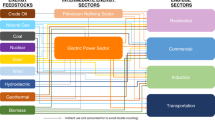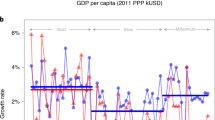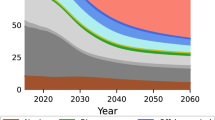Abstract
Long-term projections of energy consumption, supply and prices heavily influence decisions regarding long-lived energy infrastructure. Predicting the evolution of these quantities over multiple years to decades is a difficult task. Here, we estimate year-on-year volatility and unpredictability over multi-decade time frames for many quantities in the US energy system using historical projections. We determine the distribution over time of the most extreme projection errors (unpredictability) from 1985 to 2014, and the largest year-over-year changes (volatility) in the quantities themselves from 1949 to 2014. Our results show that both volatility and unpredictability have increased in the past decade, compared to the three and two decades before it. These findings may be useful for energy decision-makers to consider as they invest in and regulate long-lived energy infrastructure in a deeply uncertain world.
This is a preview of subscription content, access via your institution
Access options
Access Nature and 54 other Nature Portfolio journals
Get Nature+, our best-value online-access subscription
$29.99 / 30 days
cancel any time
Subscribe to this journal
Receive 12 digital issues and online access to articles
$119.00 per year
only $9.92 per issue
Buy this article
- Purchase on SpringerLink
- Instant access to full article PDF
Prices may be subject to local taxes which are calculated during checkout






Similar content being viewed by others
Change history
12 March 2019
In the version of this Analysis originally published, the key for the size frequency in Fig. 4 was erroneously switched, and should have read 5% for the small black dot, and 50% for the large black dot. This has now been amended.
References
Value Added by Industry (US Bureau of Economic Analysis, 2017).
Smil, V. Perils of long-range energy forecasting: reflections on looking far ahead. Technol. Forecast. Soc. Change 65, 251–264 (2000).
Huss, W. R. Can electric utilities improve their forecast accuracy? The historical perspective. Public Util. Fortn. 3–8 (26 December 1985).
Huss, W. R. Comparative analysis of company forecasts and advanced time series techniques using annual electric utility energy sales data. Int. J. Forecast. 1, 217–239 (1985).
Huss, W. R. What makes a good load forecast. Public Util. Fortn. 3–11 (28 November 1985).
Nelson, C. R. & Peck, S. C. The NERC fan: A retrospective analysis of the NERC summary forecasts. J. Bus. Econ. Stat. 3, 179–187 (1985).
Landsberg, H. Energy in transition: A view from 1960. Energy J. 6, 1–18 (1985).
Huntington, H. G. Oil price forecasting in the 1980s: What went wrong? Energy J. 15, 1–22 (1994).
Sohn, I. Long-term energy projections: What lessons have we learned? Energy Policy 35, 4574–4584 (2007).
Issues in Midterm Analysis and Forecasting 1996 (Energy Information Administration, 1996).
Shlyakhter, A. I., Kammen, D. M., Broido, C. L. & Wilson, R. Quantifying the credibility of energy projections from trends in past data: The US energy sector. Energy Policy 22, 119–130 (1994).
Kaack, L. H., Apt, J., Morgan, M. G. & McSharry, P. Empirical prediction intervals improve energy forecasting. Proc. Natl Acad. Sci. USA 114, 8752–8757 (2017).
Craig, P. P., Gadgil, A. & Koomey, J. G. What can history teach us? A retrospective examination of long-term energy forecasts for the United States. Annu. Rev. Energy Environ. 27, 83–118 (2002).
Bezdek, R. H. & Wendling, R. M. A half century of long-range energy forecasts: errors made, lessons learned, and implications for forecasting. J. Fusion Energy 21, 155–172 (2002).
Koomey, J., Craig, P., Gadgil, A. & Lorenzetti, D. Improving long-range energy modeling: A plea for historical retrospectives. Energy J. 24, 75–92 (2003).
Linderoth, H. Forecast errors in IEA-countries’ energy consumption. Energy Policy 30, 53–61 (2002).
Auffhammer, M. The rationality of EIA forecasts under symmetric and asymmetric loss. Resour. Energy Econ. 29, 102–121 (2007).
O’Neill, B. C. & Desai, M. Accuracy of past projections of US energy consumption. Energy Policy 33, 979–993 (2005).
Winebrake, J. J. & Sakva, D. An evaluation of errors in US energy forecasts: 1982–2003. Energy Policy 34, 3475–3483 (2006).
Considine, T. J. & Clemente, F. A. Gas-market forecasts: Betting on bad numbers. Public Util. Fortn. 53–59 (July 2007).
Fischer, C., Herrnstadt, E. & Morgenstern, R. Understanding errors in EIA projections of energy demand. Resour. Energy Econ. 31, 198–209 (2009).
Wara, M., Cullenward, D. & Teitelbaum, R. Peak electricity and the clean power plan. Electr. J 28, 18–27 (2015).
Gilbert, A. Q. & Sovacool, B. K. Looking the wrong way: Bias, renewable electricity, and energy modelling in the United States. Energy 94, 533–541 (2016).
Annual Energy Outlook reports, 1982–1987, and 1989–2015 (Energy Information Administration, 1983–2015).
Energy Policy Act Transportation Study: Interim Report on Natural Gas Flows and Rates (Energy Information Administration, 1995).
Annual Energy Outlook Retrospective Review: Evaluation of 2014 and Prior Reference Case Projections (Energy Information Administration, 2015).
Form EIA-860 detailed data, 2013 (Energy Information Administration, 2014).
Kilian, L. & Hicks, B. Did unexpectedly strong economic growth cause the oil price shock of 2003–2008? J. Forecast. 32, 385–394 (2013).
Sundquist, E. & McCahill, C. For the First Time in a Decade, U.S. Per Capita Highway Travel Ticks up (State Smart Transportation Initiative, 2015).
Monthly Energy Review November 2015, 85 (Energy Information Administration, 2015).
Current-Dollar and ‘Real’ Gross Domestic Product (US Department of Commerce Bureau of Economic Analysis, 2015).
Gross Domestic Product: Implicit Price Deflator [A191RI1A225NBEA] (US Bureau of Economic Analysis, 2016).
Acknowledgements
We acknowledge and thank L. H. Kaack of Carnegie Mellon University for sharing the substantial task of data collection and harmonization, as well as J. Apt, M. G. Morgan, A. Davis, W. M. Griffin, E. Rubin, M. Small, G. Wong-Parodi, D. Armanios and S. Feinberg for their thoughtful feedback and advice. The final figures in the Supplementary Information benefited from editorial changes and suggestions from S. J. Davis. This material is based on work supported by the National Science Foundation Graduate Research Fellowship Program under grant no. DGE-1252522. This work was funded in part by the Center for Climate and Energy Decision Making (SES-0949710 and SES-1463492), through a cooperative agreement between the National Science Foundation and Carnegie Mellon University. Any opinions, findings and conclusions or recommendations expressed in this material are those of the authors and do not necessarily reflect the views of the National Science Foundation.
Author information
Authors and Affiliations
Contributions
E.D.S. and I.M.L.A. secured project funding; E.D.S., I.M.L.A. and M.H. designed the study; E.D.S. analysed the data with iterative feedback from I.M.L.A. and M.H.; E.D.S. created the figures; E.D.S., I.M.L.A. and M.H. drafted and edited the manuscript.
Corresponding author
Ethics declarations
Competing interests
The authors declare no competing interests.
Additional information
Publisher’s note: Springer Nature remains neutral with regard to jurisdictional claims in published maps and institutional affiliations.
Supplementary information
Supplementary Information
Supplementary Figures 1–16, Supplementary Tables 1–3, Supplementary Notes 1–12, Supplementary Discussion, Supplementary Methods and Supplementary References.
Supplementary Data 1
The data behind Figures 3 and 4
Supplementary Data 2
Cross-quantity and serial correlations within Annual Energy Outlook projections and projection errors, as well as cross-quantity correlations between historical values
Rights and permissions
About this article
Cite this article
Sherwin, E.D., Henrion, M. & Azevedo, I.M.L. Estimation of the year-on-year volatility and the unpredictability of the United States energy system. Nat Energy 3, 341–346 (2018). https://doi.org/10.1038/s41560-018-0121-4
Received:
Accepted:
Published:
Issue Date:
DOI: https://doi.org/10.1038/s41560-018-0121-4
This article is cited by
-
A framework to predict the price of energy for the end-users with applications to monetary and energy policies
Nature Communications (2021)
-
Rapid cost decrease of renewables and storage accelerates the decarbonization of China’s power system
Nature Communications (2020)
-
Predicting unpredictability
Nature Energy (2018)



